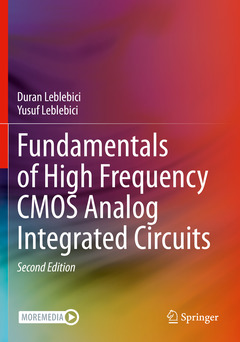Description
Fundamentals of High Frequency CMOS Analog Integrated Circuits (2nd Ed., 2nd ed. 2021)
Authors: Leblebici Duran, Leblebici Yusuf
Language: English
Subjects for Fundamentals of High Frequency CMOS Analog Integrated...:
63.29 €
In Print (Delivery period: 15 days).
Add to cartPublication date: 03-2022
342 p. · 17.8x25.4 cm · Paperback
89.66 €
In Print (Delivery period: 15 days).
Add to cartPublication date: 03-2021
342 p. · 17.8x25.4 cm · Hardback
Description
/li>Contents
/li>Biography
/li>Comment
/li>
This textbook is ideal for senior undergraduate and graduate courses in RF CMOS circuits, RF circuit design, and high-frequency analog circuit design. It is aimed at electronics engineering students and IC design engineers in the field, wishing to gain a deeper understanding of circuit fundamentals, and to go beyond the widely-used automated design procedures. The authors employ a design-centric approach, in order to bridge the gap between fundamental analog electronic circuits textbooks and more advanced RF IC design texts. The structure and operation of the building blocks of high-frequency ICs are introduced in a systematic manner, with an emphasis on transistor-level operation, the influence of device characteristics and parasitic effects, and input?output behavior in the time and frequency domains.
This second edition has been revised extensively, to expand some of the key topics, to clarify the explanations, and to provide extensive design examples and problems. New material has been added for basic coverage of core topics, such as wide-band LNAs, noise feedback concept and noise cancellation, inductive-compensated band widening techniques for flat-gain or flat-delay characteristics, and basic communication system concepts that exploit the convergence and co-existence of Analog and Digital building blocks in RF systems. A new chapter (Chapter 5) has been added on Noise and Linearity, addressing key topics in a comprehensive manner. All of the other chapters have also been revised and largely re-written, with the addition of numerous, solved design examples and exercise problems.Components of Analog CMOS ICs.- Basic MOS Amplifiers: DC and Low Frequency Behavior.- High Frequency Behavior of Basic Amplifiers.- Frequency-Selective RF Circuits.- Noise and Linearity in Amplifiers.- RF OSCILLATORS.- Analog-Digital Interfaces.
Duran Leblebici is Professor Emeritus of Electrical and Electronics Engineering at Istanbul Technical University (ITU). He has been teaching a range of undergraduate and graduate courses, from device electronics and fabrication technologies to integrated electronic circuits and RF IC design, for more than 50 years. He is the author of three textbooks in the field of electronics. He also established the first microelectronics laboratory and the first VLSI design house at ITU. He has received the Distinguished Service Award of the Turkish Scientific and Technological Research Council (TUBITAK) in 1992, in recognition of his services to microelectronics education.
Yusuf Leblebici is President of Sabancı University, and former Director and Chair Professor of the Microelectronic Systems Laboratory at the Swiss Federal Institute of Technology in Lausanne (EPFL). He has previously worked as a faculty member at the University of Illinois at Urbana-Champaign, at Istanbul Technical University, and at Worcester Polytechnic Institute (WPI), where he established and directed the VLSI Design Laboratory, and also served as a project director at the New England Center for Analog and Mixed-Signal IC Design. He is the co-author of more than 400 scientific articles and six textbooks.
These books may interest you

RF microelectronics 104.84 €



